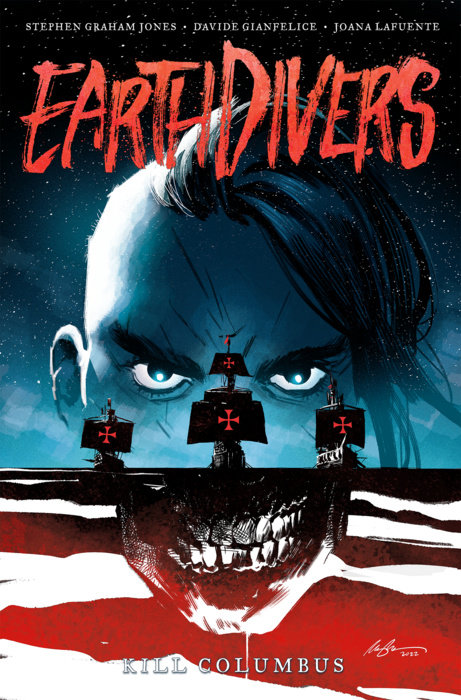Time Travel Is Bloody: On “Earthdivers: Kill Columbus”

The first comic book I wrote about in this space was the first volume of Department of Truth. Since then, I’ve largely stuck to self-contained volumes - though it’s worth mentioning here that Know Your Station’s spine design suggests it’s the first book in a series, and that Sins of the Black Flamingo certainly feels like it could be the first book in a series. Some of that is the challenge of writing about something that’s only part of a larger whole; I suspect I’ll get to Coda, Home Sick Pilots, and We Only Find Them When They’re Dead in this space, but if I do so it’s almost certain to be pieces focusing on the entire run of all three series.

All of which brings us to Earthdivers: Kill Columbus, the first volume in an ongoing series by writer Stephen Graham Jones and artist Davide Gianfelice. The premise is relatively simple: it’s 2112, but we’re a long ways away from libertarian-leaning prog albums. Instead, the Earth’s environment is devastated, and many affluent people have headed to the stars. A quartet of Indigenous people have a plan to save the planet by altering history; there’s this cave, you see, and it has the ability to send a single person back in time. Cue protagonist Tad, who steps into the cave and arrives in 1492, where his mission is simple, and should be relatively easy to discern from the book’s title.
There’s more to it than that — Tad’s three comrades remaining in the 22nd century, including his wife Sosh, await evidence that history has changed, and instead gradually become aware of other properties of the time travel mechanics happening around them. Those mysteries seem to be establishing some longer-running questions for the book. If this is an example of mystery box storytelling, the cave is very much the cubical object in question.
In his introduction to this volume, Jones explains that the origin of the “Kill Columbus” subtitle goes back a long ways for him. “Every Native kid who’s ever sat in the back of their elementary school classroom and been forced to listen to what a hero and legend this dude not only was but apparently is still supposed to be, they’ve probably considered this,” he writes. It’s worth mentioning, though, that the vast majority of Jones’s prose falls, broadly, into the category of horror — and Earthdivers isn’t too far removed from that.
Here, Jones isn’t tapping into the meta-slasher narratives that have suffused some of his fiction, or the folkloric elements that have shown up in others. (This includes the short novel Mapping the Interior, which I’d argue is one of the handful of examples of North American folk horror — but that’s a discussion to be had elsewhere.) Instead, it’s a kind of moral horror; upon arriving in the past, one of the first things Tad does is murder a crewman scheduled to be a part of Columbus’s voyage so that Tad can take his place.
While plenty of the sailors (to say nothing of Columbus himself) are portrayed unsympathetically, it’s telling that they’re not the ones that Tad has to reckon with over the course of the narrative. Instead, he’s forced to get relatively innocent blood on his hands along the way — something that creates a sense of creeping moral horror to linger. (Alternately: there’s an oft-cited Nietzsche aphorism about fighting monsters that would work well here.)
Tad is at the center of this book, though his three colleagues who remain in the future have a subplot in which they learn more about just what the cave can do and find their own bonds to one another tested. Gianfelice’s art is equally suited to the sweep of Tad’s adventures in the past and the textures and landscapes at work in the 2112 sequences. Gianfelice also gives each of the quartet of time travelers — Tad, Sosh, Emily and Yellow Kidney — a distinctive look and body language. Joana Lafuente’s coloring also does a nice job of shifting from relative realism to a more hallucinatory state as Tad’s quest becomes increasingly surreal.
Earthdivers: Kill Columbus ends with an intriguing glimpse of what’s to come; it also tells a fascinating and self-contained story of one man on a journey to do something monumental with the best intentions. What happens when wish fulfillment becomes the stuff of nightmares? In the case of this book, you have a compelling start to a larger narrative — and one that marks Jones as the latest writer known for their prose to make a bold foray into another mode of storytelling.
As always, I'm Tobias Carroll, and this has been Postcards From Komiksoj.
This newsletter is free, but if you’re so inclined, I have a page at Ko-Fi where you can buy me a (metaphorical) cup of coffee. My novel In the Sight is available here, and details on upcoming readings can be found here.
If you're interested in buying any of the books reviewed in these pages, most of them can be ordered via Bookshop.